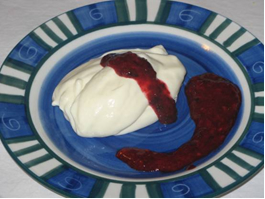Archive
Simonsig Gewürztraminer: the perfect wine with Lemon Mousse
| Preparation Time: 10 minutes | Chilling Time: 60 minutes | Yield: 4-6 |
 Isn’t it amazing where recipes can emerge from? A dinner for friends Ann and Garth Coetzee’s 17th wedding anniversary last Saturday evening caused me to tackle biryani for the first time (more about that next week), and since Annie loves making desserts, she brought along one of her favourites.
Isn’t it amazing where recipes can emerge from? A dinner for friends Ann and Garth Coetzee’s 17th wedding anniversary last Saturday evening caused me to tackle biryani for the first time (more about that next week), and since Annie loves making desserts, she brought along one of her favourites.
I tend to avoid desserts, as I do not have what is referred to as a “sweet tooth”. Well, that’s what I usually declaim when I encounter a dessert that I really like, but as dear daughter Alex (she of the sharp tongue) pointed out on Saturday evening, “Dad, you always say that, but with the number of desserts you now eat…..” and left it at that! I actually don’t like really sweet things, so I think what does it for me in this dessert, is the tartness which the lemon juice brings, to off-set the sweetness of the condensed milk.
I liked this one very much; so much so in fact, that I had a second helping there and then, followed by a third on Sunday while writing the recipe! Read more…
Out of the rot comes forth sweetness

Die Bergkelder's 2009 Fleur du Cap Noble Late Harvest, the first vintage to be made from Chenin Blanc
Pieter Badenhorst of Fleur du Cap is the first winemaker I’ve listened to who actually explains the intricacies, pitfalls and barnacles inherent in making a noble late harvest (NLH) or noble rot wine.
Most all other explanations I’ve heard are glib and misleading, as if this benign fungus invades the vineyard and gently turns the grapes into super-sweet raisins, while the viticulturist and winemaker sit back with arms folded waiting for the right moment to harvest.
Nothing could be further from the truth. The fungus Botrytis cinerea infects grapes during the flowering stage but it manifests much later during the ripening stage. Intense humidity followed by longer dry warm periods at just the right time, results in noble rot (édelfaule in German), whereas sustained humidity with no warm periods of relieving dryness, leads to grey rot, The former is divine the latter, disastrous.
The most prevalent legend about the origins of botrytised wines says that the Reisling producers of Schloss Johannisberg (Geisenheim in the Rheingau region, not Jhb SA!) had to wait for the permission of the estate owner, Heinrich von Bibra, Bishop of Fulda, to commence the harvest. In 1775, the abbey messenger was waylaid en route by brigands and the ensuing delay of three weeks allowed the Botriytis to take hold. The shrivelled, raisin-like grapes were considered worthless, and given to the local peasants, who made a surprisingly good sweet wine, the very first “late harvest” or as it became known, Spatlëse. Read more…